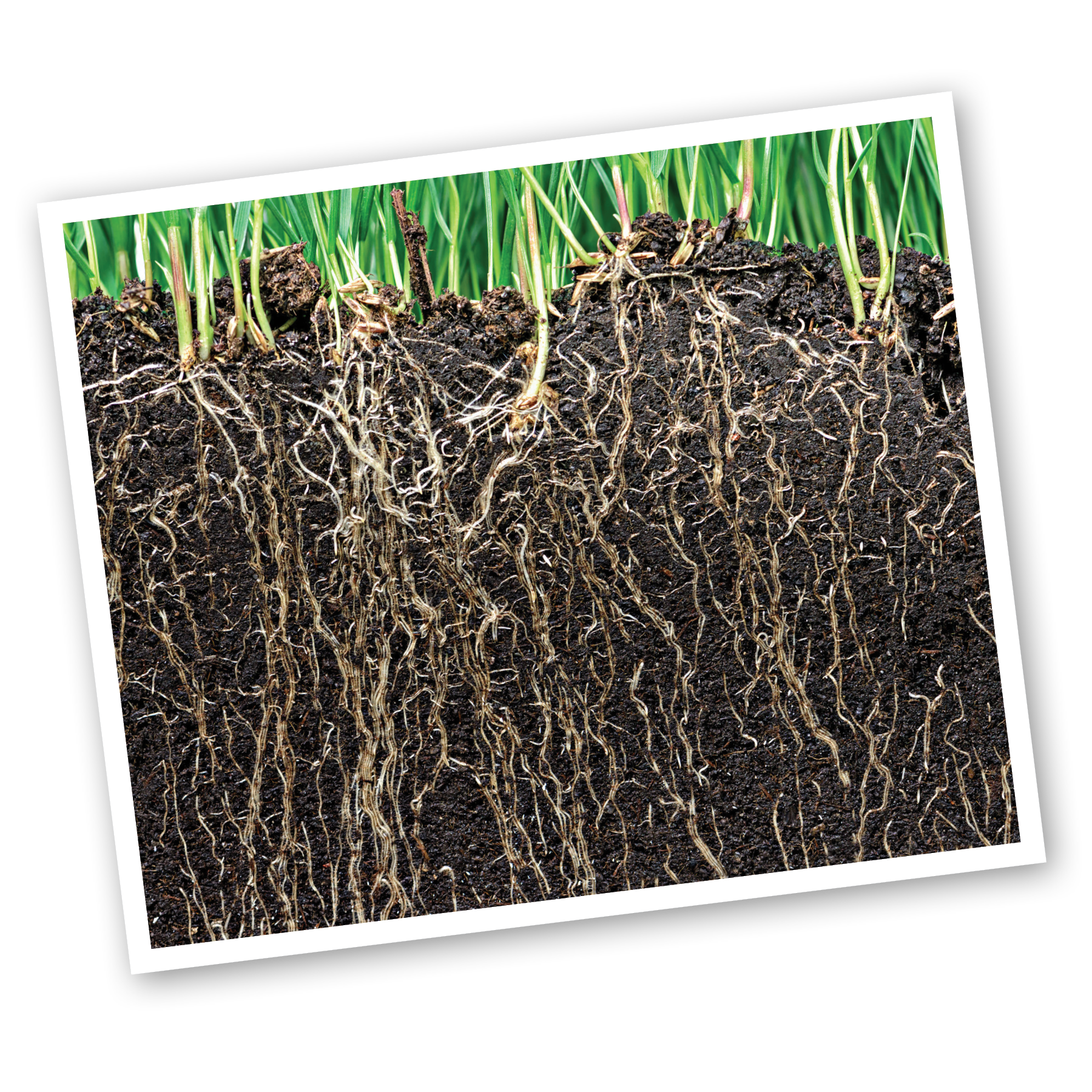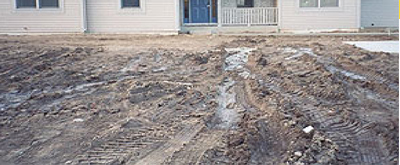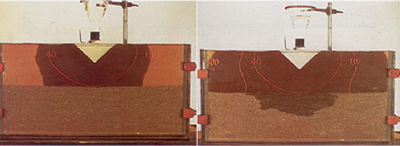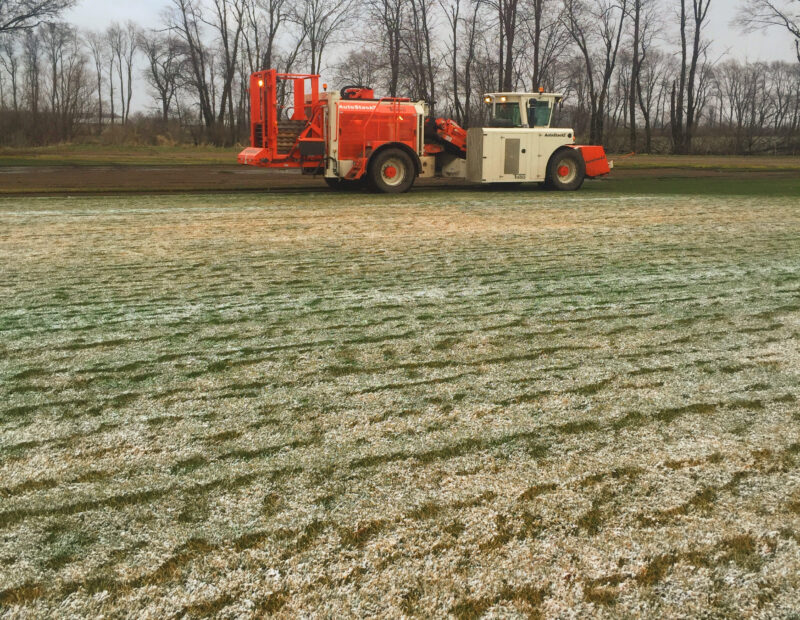
Soil is composed of particles of sand, silt, clay, rocks, organic matter, microorganisms and pore spaces. Different soils have different amounts of these materials. Silt, clay and organic matter are responsible for the soil retaining water and nutrients like nitrogen, phosphorus, and potassium. Pore spaces are where roots grow, the path water takes into the soil when it rains, and most importantly, the pathway of oxygen for the plant roots. Microorganisms perform the very important function of breaking down and recycling organic compounds like old grass plants and air pollutants that fall to the ground.
At undisturbed locations, topsoil is the soil on top of the ground. It usually contains more nutrients, organic matter and microorganisms than subsoil, and will better support plant growth. Subsoil is below the topsoil and has fewer nutrients, organic matter and microorganisms, which can make growing plants from seed quite challenging. The purpose of adding topsoil is to increase the water and nutrient holding capacity of an existing soil.
Pore spaces are cavities in the soil that allow water to pass through when it rains, and serve as a channel for oxygen to reach the roots. An ideal soil is 50% pore spaces! Construction vehicle traffic, bulldozing a final grade, and dogs running in the same path all compact a soil, which reduces the size and number of pore spaces. Compaction often increases when tillage is performed when the soil is wet rather than dry. An impatient homeowner demanding that a landscaper rake and install a lawn when the soil is too wet causes tremendous compaction, which greatly affects the lawn for years to come.
Proper or improper soil preparation before a lawn is installed will have a huge impact on how a lawn looks, and the amount of money it takes to maintain the lawn for years to come. Proper lawn preparation before the turf is installed costs almost nothing compared to what it costs to correct something done wrong after the turf is installed.

Soil is composed of particles of sand, silt, clay, rocks, organic matter, microorganisms and pore spaces. Different soils have different amounts of these materials. Silt, clay and organic matter are responsible for the soil retaining water and nutrients like nitrogen, phosphorus, and potassium. Pore spaces are where roots grow, the path water takes into the soil when it rains, and most importantly, the pathway of oxygen for the plant roots. Microorganisms perform the very important function of breaking down and recycling organic compounds like old grass plants and air pollutants that fall to the ground.
At undisturbed locations, topsoil is the soil on top of the ground. It usually contains more nutrients, organic matter and microorganisms than subsoil, and will better support plant growth. Subsoil is below the topsoil and has fewer nutrients, organic matter and microorganisms, which can make growing plants from seed quite challenging. The purpose of adding topsoil is to increase the water and nutrient holding capacity of an existing soil.
Pore spaces are cavities in the soil that allow water to pass through when it rains, and serve as a channel for oxygen to reach the roots. An ideal soil is 50% pore spaces! Construction vehicle traffic, bulldozing a final grade, and dogs running in the same path all compact a soil, which reduces the size and number of pore spaces. Compaction often increases when tillage is performed when the soil is wet rather than dry. An impatient homeowner demanding that a landscaper rake and install a lawn when the soil is too wet causes tremendous compaction, which greatly affects the lawn for years to come.
Proper or improper soil preparation before a lawn is installed will have a huge impact on how a lawn looks, and the amount of money it takes to maintain the lawn for years to come. Proper lawn preparation before the turf is installed costs almost nothing compared to what it costs to correct something done wrong after the turf is installed.
How can I create the best environment for my new lawn?
Creating a hospitable environment for your new lawn depends on what kind of soil is present, and what your expectations for your lawn are. Keeping these points in mind will help you decide what is best for you.

This rutted up lawn is typical of most new homes. The soil needs to be tilled
at least 4 inches deep to eliminate soil compaction
An equally important benefit of tilling a soil is to eliminate the presence of different soil layers. Examples of layering would be when subsoil from a basement is spread out over what will be a lawn, or soil is brought in to fill low spots. Different layers of soil interfere with water movement and root penetration; the layers slow down water movement, keeping soil pores filled with water, preventing the roots from receiving oxygen.

Normal water movement slows when it reaches a different layer of soil.
If you have soil that does not have much nutrient-heavy clay, and you have high expectations for your lawn, adding two inches of topsoil and mixing it into the soil will provide good benefits. If the topsoil will not be mixed into the existing soil, then don’t apply it, because it would mean creating another layer.
Sandy soils are not automatically bad; they just have to be managed differently once the turf has been established. Because sandy soils lack water and nutrient holding capacity, the interval between watering and fertilizing will be shorter than if topsoil were added. Instead of fertilizing every 6 weeks, a lawn without topsoil might need to be fertilized in 4 weeks.
How can I create the best environment for my new lawn?
Creating a hospitable environment for your new lawn depends on what kind of soil is present, and what your expectations for your lawn are. Keeping these points in mind will help you decide what is best for you.

This rutted up lawn is typical of most new homes. The soil needs to be tilled at least 4 inches deep to eliminate soil compaction
An equally important benefit of tilling a soil is to eliminate the presence of different soil layers. Examples of layering would be when subsoil from a basement is spread out over what will be a lawn, or soil is brought in to fill low spots. Different layers of soil interfere with water movement and root penetration; the layers slow down water movement, keeping soil pores filled with water, preventing the roots from receiving oxygen.

Normal water movement slows
when it reaches a different layer of soil.
If you have soil that does not have much nutrient-heavy clay, and you have high expectations for your lawn, adding two inches of topsoil and mixing it into the soil will provide good benefits. If the topsoil will not be mixed into the existing soil, then don’t apply it, because it would mean creating another layer.
Sandy soils are not automatically bad; they just have to be managed differently once the turf has been established. Because sandy soils lack water and nutrient holding capacity, the interval between watering and fertilizing will be shorter than if topsoil were added. Instead of fertilizing every 6 weeks, a lawn without topsoil might need to be fertilized in 4 weeks. This is a seeded lawn on a sandy soil that failed. The owners gave up trying to grow the lawn from seed and had it sodded.

Updated 12/5/25
Red Hen Turf Farm’s
2025 Sod Harvesting Season
has OFFICIALLY ENDED
as of 12/5/25
due to SNOW / Precipitation and Unfavorable Field Conditions.
We had hoped to keep going until 12/19/25, but Mother Nature did not get that Memo, apparently :)
* * *
If you’re reading this in early 2026 and wonder when we might start back up again, a quick call will confirm our
SOD HARVEST FORECAST
– 574-232-6811 –
is the number to call.